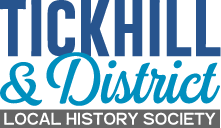

Articles Menu
 GO
GOAmong Doncaster Archives’ material on Tickhill is a book containing records of the Overseers of the Poor and the Churchwardens. Meetings, minutes, resolutions and accounts from the 18th Century to the mid 19th Century are contained in the Township Book (Ref. No.: P56/6/A1).
Read more >> GO
GOThanks to Sue and Joe Green, TDLHS now has a copy of the list of Tickhill’s Electors in 1904, priced originally at one shilling. As well as giving details of who was eligible to vote in parliamentary, county council and parochial council elections, this Register of Electors provides several insights into life in Tickhill and into national policies at the beginning of the 20th Century.
Read more >> GO
GOAll those on Tickhill’s Register of Electors in 1904 who were eligible to vote in parochial, that is Urban District Council, elections were not able to exercise this right. The UDC minutes of 11 April 1904 record that no poll was held for the three available positions on the Council.
Read more >> GO
GOFounded in 1883 by Sir Winston Churchill's father, Lord Randolph Churchill, and other leading Conservatives, the League was a ploy to boost support for the Conservative Party across all classes and increase the likelihood of Conservative candidates winning elections.
Read more >> GO
GOBy today's standards it seems extraordinary that in the 18th Century only two parliamentary elections saw seats contested in the Yorkshire County Constituency
Read more >> GO
GOSixty six years after the County Constituency of Yorkshire had a contested parliamentary election, 1807 saw another electoral contest.
Read more >> GO
GOWhile Edward I was away on a Crusade in the Holy Land, officials and landowners took advantage to feather their own nests, oppressing local people in the process. On his return, Edward was swift to clamp down on malpractice.
Read more >> GO
GOThe Association began towards the end of the 18th century, focused initially on the theft of horses, but later covered all felons
Read more >> GO
GOA photograph identifying members of the UDC in 1950s
Read more >> GO
GOTickhill Local Board was set up under legislation of 1848 which concerned health but was subsequently widened to cover many local issues, including highways, parks and housing.
Read more >> GO
GOThere seemed to be a seamless transition from Board to Council in 1894-95. Up to the outbreak of war in 1914, the minutes continue to contain many references to highway repairs and to continuing problems with drains, sewage and polluted water, while the regular reports from Medical Officer of Health and Sanitary Inspector tell a story of insanitary and defective dwellings contributing to disease.
Read more >> GO
GOIn many respects, life proceeded as usual judging by the Council’s minute book. There were still the regular issues such as clearing out drains, responding to the Medical Officer’s concerns over unfit housing, non-payment of rates, the price of gas, passenger services on the railway and roadmen’s wages.
Read more >> GO
GOA major preoccupation of the Council in the decade following war was the provision of new houses. The Housing Act (1919) provided subsidies for 3 years to local authorities to build houses for rent, the Housing Act (1923) gave subsidies to private builders to do likewise and 1924 legislation repeated the subsidies to local authorities. The resulting activity is evident in the Council’s minutes.
Read more >> GO
GOWhile many items of business remained the same, there was a new preoccupation - a dominant feature of the Council’s work right through to 1972, was housing, where local responsibility for adequate provision became vital in the post-war years.
Read more >> GO
GOFrom 1777 all those who employed male servants had to pay a tax, as part of a strategy to increase tax revenues before income tax began. Another example is the windows tax of 1696.
Read more >> GO
GOWaywardens were unpaid officials elected by the parishes to collect rates, and oversee repairs to roads and footpaths deemed necessary by a paid surveyor
Read more >> GO
GOA notice to residents in 1909 from Tickhill Urban District Council regarding requirements to protect a clean water supply and avoid contamination
Read more >>